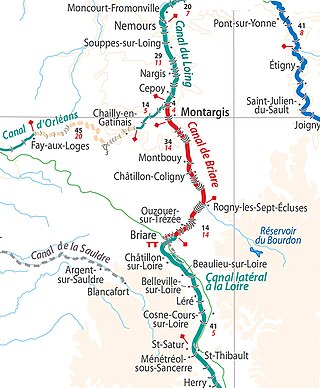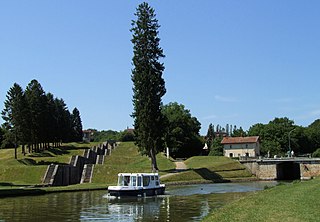Canal de Briare
| Canal de Briare | |
|---|---|
| Water code | FR : ---- 0342 |
| location | France , Center-Val de Loire and Bourgogne-Franche-Comte regions |
| length | 57 km |
| Built | 1604-1642 |
| class | I ( Freycinet class ) |
| Beginning | City port of Briare , formerly confluence with the Loire |
| The End | It flows into the Canal du Loing north of Montargis |
| Descent structures | 36 |
| Ports | Briare, Montargis |
| Junctions, crossings | Canal latéral à la Loire , Canal d'Orléans |
| Outstanding structures | Former seven-step lock staircase at Rogny-les-Sept-Écluses |
| Kilometrage | from Briare to Montargis |
|
At the former lock staircase of Rogny-les-Sept-Écluses, on the right under the bridge the lowest lock in the new canal section |
|
The Canal de Briare is a shipping canal in the French regions of Center-Val de Loire and Bourgogne-Franche-Comté . Together with the Canal du Loing , Canal latéral à la Loire and Canal du Center, it forms a chain of canals ( Route Bourbonnais ) which served to supply Paris. Today it enables barges and pleasure craft to cross from the Seine to the Saône and on over the Rhône to the Mediterranean .
course


The canal begins in the city port of Briare , where it used to connect to the Loire . Three kilometers further, the Canal latéral à la Loire branches off, which crosses the Loire Valley with the help of a trough bridge. Many ships therefore no longer go down to the city port of Briare, but use the commercial port, which is located on the Loire canal directly in front of the canal bridge .
The Canal de Briare initially runs in a north-easterly direction, but later swings to the northwest and after a length of 57 kilometers just north of Montargis , near Buges , reaches the Canal du Loing. The Canal d'Orléans , which is currently closed to navigation, also flows there. However, it is already being repaired.
Coordinates
- Starting point of the canal: 47 ° 38 ′ 20 ″ N , 2 ° 43 ′ 46 ″ E
- End point of the canal: 48 ° 1 ′ 39 ″ N , 2 ° 43 ′ 20 ″ E
Crossed departments
in the Center-Val de Loire region:
in the Burgundy region:
Places on the canal
technical infrastructure
The canal is the oldest watershed canal in France and has a total of 36 locks . 12 of them lead to the ascent of 40 meters from the Loire Valley, the other 24 to descent of around 80 meters towards the Seine. It first follows the Trézée river and reaches its apex position at 165 meters above sea level, where several reservoirs have been created for its water supply.
The reservoirs are u. a. supplied with water by a pumping station in Briare via the stream-like gully Rigole d'Alimentation du Canal de Briare . To the west of Ouzouer-sur-Trézée , this water is conducted in a double-pipe culvert , which in turn crosses the canal on a lattice bridge. In addition, the Rigole de St-Privée supplies water to the lakes over 16 kilometers on a hillside. Further trenches connect the reservoirs south of Bléneau .
After its descent, the canal reaches the Loing river at Rogny-les-Sept-Écluses , which provides further water supply. The locks are designed for ships of the standard size Freycinet .
history
The construction was conceived in the 16th century and started in 1604, ordered by King Henry IV on the initiative of his minister Maximilien de Béthune, the Duke of Sully , to promote the grain trade and the fatal periods of famine caused by supply shortages in Paris at that time already had 500,000 inhabitants. Between six and twelve thousand workers were involved in this construction project, which connects the Seine with the Loire basin . Hugues Cosnier was the first to receive the order to cross a watershed with a canal. In the famous Rogny lock staircase at the place named after it, Rogny-les-Sept-Écluses ( sept écluses = seven locks), seven barrages were connected in a row in order to overcome a level difference of almost 25 m over a few hundred meters. Although it was decommissioned in 1887 by a bypass line, it can still be viewed today as a unique technical monument (illuminated by floodlights at night).
After the king was assassinated in 1610, construction was suspended until 1638, before Cardinal Richelieu opened the canal in 1642 . The Canal de Briare can be regarded as a model for the Canal du Midi , which was started later , as it had been studied in detail by its builder Pierre-Paul Riquet in the opening year .
Attractions
- Rogny lock staircase
This seven-step, world's oldest lock staircase - like the canal - was built in the years 1604 to 1610 and 1638 to 1642, but was designed in 1579. It was the model for the originally eight-step Fonserannes lock staircase, which was commissioned in 1681 . The Rogny lock staircase has been dry since 1882, after the canal was relocated to the west over a length of about six kilometers. Since then there have been five individual locks suitable for longer ships (Freycinet class). The Rogny lock staircase has been a French architectural monument as a Monument Historique since 1983 .
- Lock stairs at Dammarie-sur-Loing

The ruins of the five-step lock staircase are located north of Dammarie-sur-Loing next to canal lock No. 21, the Écluse du Moulin Brûlé . It was built at the same time as that of Rogny along the canal. After 1.5 km of the canal with three larger individual locks on the valley slope were lowered in 1888, this lock staircase also fell into disrepair.
- Briare pumping station
(at the entrance to the trough bridge) with exhibition in the turbine hall.
- Aqueduc de la Trézée
Located about one kilometer west of Ouzouer-sur-Trézée, the Aqueduc de la Trézée carries the double- pipe culvert of the Rigole d'Alimentation du Canal de Briare over the Trézée as a steel lattice structure of 170 m length .
Web links
literature
- Voies Navigables, Canaux du Center , 1998, Editions Grafocarte publishing house ISBN 2-7416-0058-9
Individual evidence
- ↑ a b The information on the length of the canal is based on the information on the Canal de Briare from SANDRE (French), accessed on November 11, 2011, rounded to the nearest kilometer.
- ↑ The Rogny lock staircase in the Base Mérimée of the French Ministry of Culture (French)




